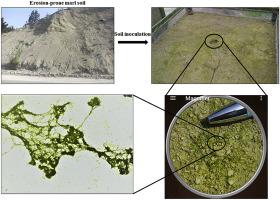当前位置:
X-MOL 学术
›
Eur. J. Soil Biol.
›
论文详情
Our official English website, www.x-mol.net, welcomes your
feedback! (Note: you will need to create a separate account there.)
Runoff and soil loss from small plots of erosion-prone marl soil inoculated with bacteria and cyanobacteria under real conditions
European Journal of Soil Biology ( IF 3.7 ) Pub Date : 2020-11-01 , DOI: 10.1016/j.ejsobi.2020.103214 Seyed Hamidreza Sadeghi , Mahya Sadeghi Satri , Hossein Kheirfam , Behrouz Zarei Darki
European Journal of Soil Biology ( IF 3.7 ) Pub Date : 2020-11-01 , DOI: 10.1016/j.ejsobi.2020.103214 Seyed Hamidreza Sadeghi , Mahya Sadeghi Satri , Hossein Kheirfam , Behrouz Zarei Darki

|
Abstract Land degradation is a major global concern that is exacerbated in the erosion-prone marl and calcium carbonate-rich mudstone slopes. Several studies have therefore focused on finding ways to inhibit soil erosion among which, soil inoculation has been recently introduced as a new technique. However, the success of such treatment has not been adequately taken into account. Following this, in this study, we assessed the hydrological responses of an erosion-prone marl soil due to surface inoculation of bacteria and cyanobacteria. The individual bacteria and cyanobacteria and their combination were inoculated (in three repetitions) on 0.5 m × 0.5 m-sized plots filled by marl soil from the Marzanabad Region in the north of Iran. The entire plots were thoroughly exposed to natural conditions in an open area at the campus of Faculty of Natural Resources of Tarbiat Modares University in Noor, Mazandaran Province, Iran. After 32 days of inoculation, five erosive natural rainfalls occurred on the experimental plots, from 10 to Jan. 29, 2018. The rainfalls on control plot led to a relatively high runoff yield (i.e., 223–2010 ml) and coefficient (i.e., 2.3–7.6%), a considerable soil loss (i.e., 1.32–17.96 g), and sediment concentration (i.e., 2.4–9 g l−1). Whilst, in the inoculated (i.e., bacteria, cyanobacteria, and bacteria + cyanobacteria) plots, the runoff volume, runoff coefficient, soil loss, and sediment concentration varied between 56 and 1116 ml, 2.3–9.4%, 0.16–4.04 g, and 1.01–3.61 g l−1, respectively. It, therefore, verified that the soil inoculation decreased the runoff yield and coefficient (29–77%), soil loss (77–89%), and sediment concentration (60–76%), as compared to the control. On the whole, we found that the soil inoculation technique could be considered as a bio-strategy to conserve/restore marl soil lands, where the viability of conventional methods is low.
中文翻译:

在真实条件下接种细菌和蓝藻的小块易侵蚀泥灰土的径流和土壤流失
摘要 土地退化是一个主要的全球问题,在易侵蚀的泥灰岩和富含碳酸钙的泥岩斜坡中加剧。因此,一些研究集中在寻找抑制土壤侵蚀的方法上,其中最近引入了土壤接种作为一项新技术。然而,这种治疗的成功没有得到充分考虑。在此之后,在本研究中,我们评估了由于细菌和蓝细菌的表面接种而导致易受侵蚀的泥灰土的水文响应。将单个细菌和蓝藻及其组合接种(重复 3 次)在 0.5 m × 0.5 m 大小的地块上,该地块由伊朗北部 Marzanabad 地区的泥灰土填充。整个地块都在伊朗马赞德兰省 Noor 的 Tarbiat Modares 大学自然资源学院校园的一个开放区域完全暴露在自然条件下。接种 32 d 后,试验样地发生了 5 次侵蚀性自然降雨,时间为 2018 年 1 月 10 日至 1 月 29 日。 2.3–7.6%)、相当大的土壤流失(即 1.32–17.96 g)和沉积物浓度(即 2.4–9 gl-1)。同时,在接种(即细菌、蓝细菌和细菌 + 蓝细菌)地块中,径流体积、径流系数、土壤流失和沉积物浓度在 56 到 1116 毫升、2.3-9.4%、0.16-4.04 克和分别为 1.01–3.61 gl-1。因此,它 证实与对照相比,土壤接种降低了径流产量和系数 (29-77%)、土壤流失 (77-89%) 和沉积物浓度 (60-76%)。总的来说,我们发现土壤接种技术可以被认为是一种保护/恢复泥灰质土壤的生物策略,传统方法的可行性很低。
更新日期:2020-11-01
中文翻译:

在真实条件下接种细菌和蓝藻的小块易侵蚀泥灰土的径流和土壤流失
摘要 土地退化是一个主要的全球问题,在易侵蚀的泥灰岩和富含碳酸钙的泥岩斜坡中加剧。因此,一些研究集中在寻找抑制土壤侵蚀的方法上,其中最近引入了土壤接种作为一项新技术。然而,这种治疗的成功没有得到充分考虑。在此之后,在本研究中,我们评估了由于细菌和蓝细菌的表面接种而导致易受侵蚀的泥灰土的水文响应。将单个细菌和蓝藻及其组合接种(重复 3 次)在 0.5 m × 0.5 m 大小的地块上,该地块由伊朗北部 Marzanabad 地区的泥灰土填充。整个地块都在伊朗马赞德兰省 Noor 的 Tarbiat Modares 大学自然资源学院校园的一个开放区域完全暴露在自然条件下。接种 32 d 后,试验样地发生了 5 次侵蚀性自然降雨,时间为 2018 年 1 月 10 日至 1 月 29 日。 2.3–7.6%)、相当大的土壤流失(即 1.32–17.96 g)和沉积物浓度(即 2.4–9 gl-1)。同时,在接种(即细菌、蓝细菌和细菌 + 蓝细菌)地块中,径流体积、径流系数、土壤流失和沉积物浓度在 56 到 1116 毫升、2.3-9.4%、0.16-4.04 克和分别为 1.01–3.61 gl-1。因此,它 证实与对照相比,土壤接种降低了径流产量和系数 (29-77%)、土壤流失 (77-89%) 和沉积物浓度 (60-76%)。总的来说,我们发现土壤接种技术可以被认为是一种保护/恢复泥灰质土壤的生物策略,传统方法的可行性很低。











































 京公网安备 11010802027423号
京公网安备 11010802027423号